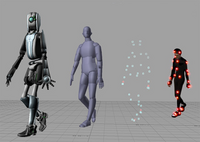
Photo from wikipedia
Tomographic volumetric additive manufacturing (VAM) is an optical 3D printing technique where an object is formed by photopolymerizing resin via tomographic projections. Currently, these projections are calculated using the Radon… Click to show full abstract
Tomographic volumetric additive manufacturing (VAM) is an optical 3D printing technique where an object is formed by photopolymerizing resin via tomographic projections. Currently, these projections are calculated using the Radon transform from computed tomography but it ignores two fundamental properties of real optical projection systems: finite etendue and non-telecentricity. In this work, we introduce 3D ray tracing as a new method of computing projections in tomographic VAM and demonstrate high fidelity printing in non-telecentric and higher etendue systems, leading to a 3x increase in vertical build volume than the standard Radon method. The method introduced here expands the possible tomographic VAM printing configurations, enabling faster, cheaper, and higher fidelity printing.
Journal Title: Optics express
Year Published: 2022
Link to full text (if available)
Share on Social Media: Sign Up to like & get
recommendations!